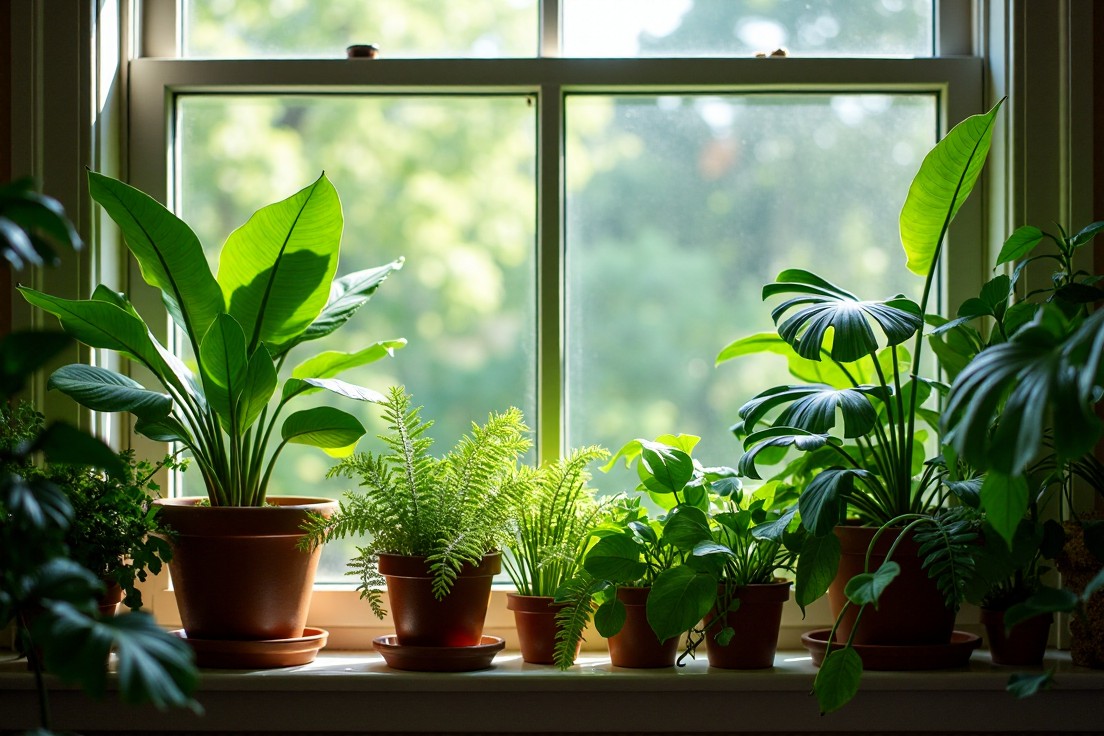
Are you looking to liven up your indoor space with beautiful plants that love humidity? If so, you’re in luck!
Many houseplants thrive in humid conditions, making them perfect for places like bathrooms and kitchens. These plants not only add green beauty to your home but also help purify the air, creating a healthier environment.
Adding houseplants to humid areas can enhance both the aesthetic and health benefits of your home. Consider the following points:
- Houseplants such as ferns and peace lilies prefer high humidity, making them ideal for bathrooms and kitchens.
- Plants like spider plants and pothos are not only hardy but also effective at filtering indoor air pollutants.
- Incorporating greenery into your space can help reduce stress and improve overall well-being.
- Regularly misting your plants can help maintain their humidity levels and keep them thriving.
- Choosing plants with cascading leaves can create a visually appealing display while benefiting from the moisture-rich environment.
Whether you’re a beginner or an experienced plant parent, it’s essential to know which plants will flourish in your specific conditions. In this guide, we’ll explore some of the best houseplants to bring into your humid spaces, along with tips on how to care for them.
When choosing houseplants for humid environments, it’s important to consider their specific needs and adaptability. Below is a table featuring some of the best plants that thrive in such conditions, along with essential care tips.
| Plant Name | Humidity Preference | Light Requirements | Watering Needs | Care Tips |
|---|---|---|---|---|
| Boston Fern | High | Indirect light | Keep soil moist | Regular misting |
| Peace Lily | Moderate to High | Low to bright indirect light | Water when top inch is dry | Avoid direct sunlight |
| Orchid | Moderate | Bright, indirect light | Let dry slightly between waterings | Use orchid-specific media |
| Spider Plant | Moderate | Indirect light | Water when top inch is dry | Easy to propagate |
| Calathea | High | Low to bright indirect light | Keep soil consistently moist | Requires some humidity |
| Bamboo Palm | Moderate to High | Indirect light | Water when top layer is dry | Good air purifier |
1. Pothos
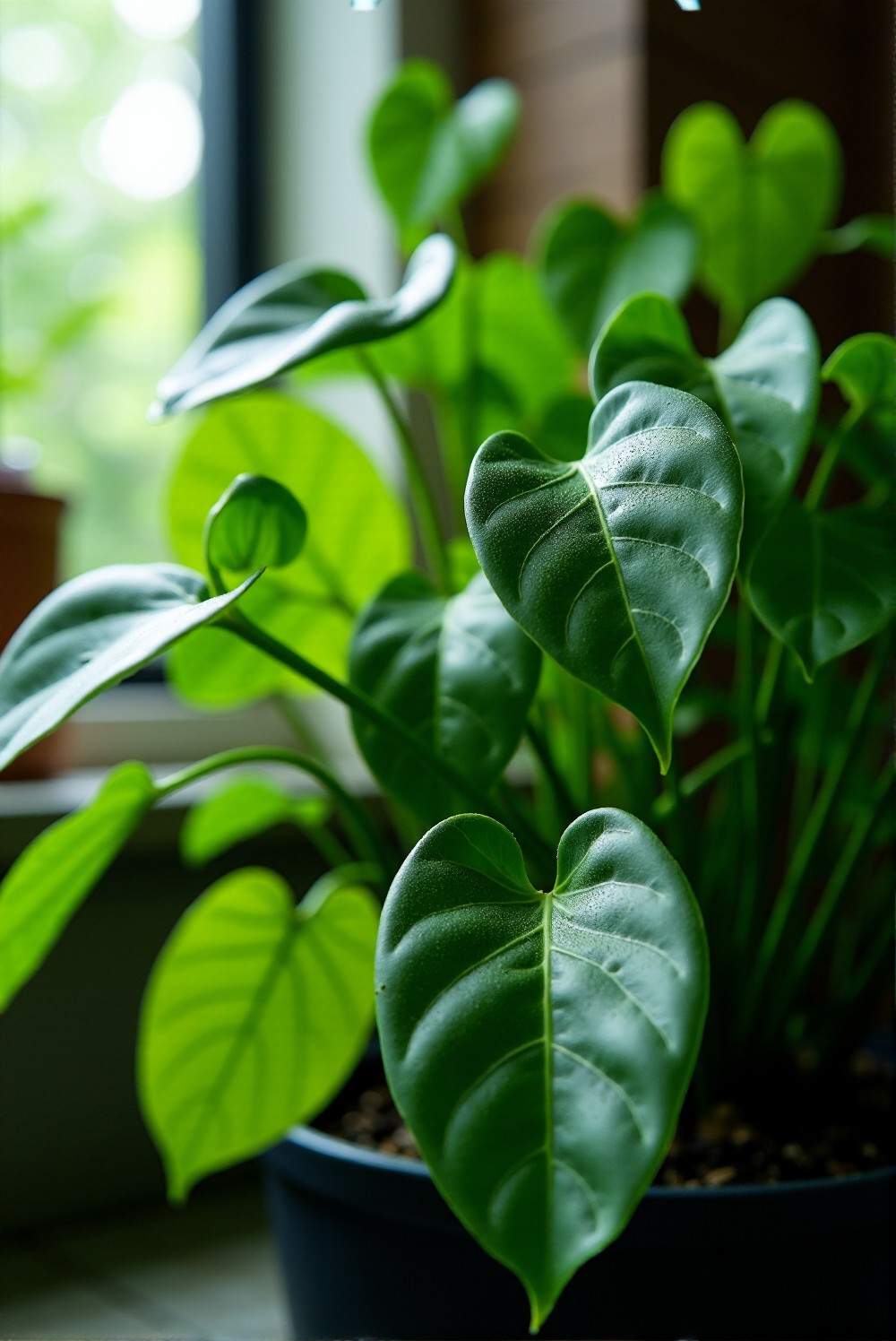
Pothos is a popular choice among houseplants. Its heart-shaped leaves can be green or variegated, adding beauty to any space.
Pothos is a well-loved houseplant known for its attractive foliage. Below is a table highlighting various aspects of the Pothos plant to enhance your understanding.
| Aspect | Details |
|---|---|
| Scientific Name | Epipremnum aureum |
| Common Names | Pothos, Devil’s Ivy, Golden Pothos |
| Leaf Shape | Heart-shaped |
| Color Variations | Green and Variegated |
| Light Requirements | Low to bright indirect light |
| Watering Needs | Allow top inch of soil to dry out between waterings |
| Benefits | Air purification and aesthetic appeal |
This plant is very forgiving, making it perfect for beginners. It can grow in low light, but bright, indirect light helps it thrive.
Pothos enjoys humidity, so placing it in a bathroom or kitchen can be beneficial.
Watering is simple.
You should let the top inch of soil dry out before giving it more water. Overwatering can lead to root rot.
Pothos can also be propagated easily by taking cuttings and placing them in water until they grow roots. This allows you to create new plants from a single one!
This plant is known for its air-purifying qualities. It can help remove indoor pollutants, which is a great bonus for any home.
Pothos does not require much fertilizer, but feeding it every few months can help promote growth.
Another fun fact about pothos is that it is quite resilient.
If the leaves start to look tired, a little trimming can refresh the plant and promote new growth. With proper care, pothos can grow long vines that create a lovely hanging display.
2. Spider Plant
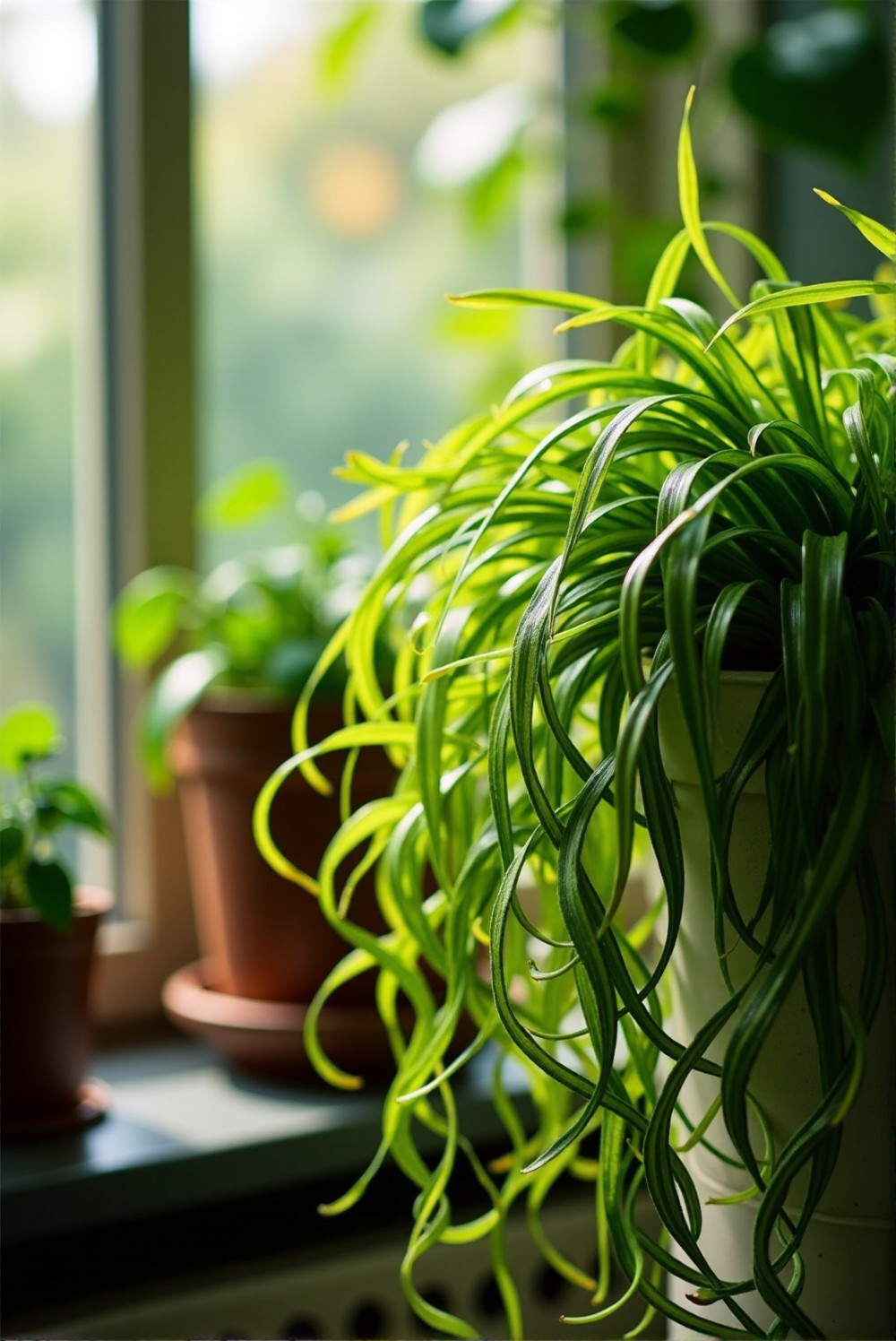
The Spider Plant, scientifically known as Chlorophytum comosum, is an eye-catching houseplant. Its long, arching leaves can be solid green or have white edges, creating a lively look that brightens up any room.
This plant thrives in humid environments, making it perfect for bathrooms or kitchens.
One of the special features of the Spider Plant is its ability to produce tiny plantlets, often referred to as “spiderettes.”
” These little plants grow on long stems and can be easily cut off and potted to start new plants. Caring for a Spider Plant is quite manageable.
It prefers well-draining soil and should be watered when the top inch of soil feels dry.
When it comes to light, the Spider Plant does well in bright, indirect sunlight but can tolerate low light conditions too.
It actively grows during the spring and summer, needing a little more water during these months. Regular misting helps enhance its growth and keeps the air around it fresh.
This plant is also celebrated for its air-purifying qualities, making it a great addition to your indoor space. By filtering harmful pollutants, it contributes to a healthier home environment.
Another plus is that the Spider Plant is generally pest-resistant. With minimal care, it can flourish for years, making it a lovely choice for both novices and seasoned plant parents.
The Spider Plant is an excellent choice for enhancing the aesthetic of any space. Here are some key benefits that make it a favorite among plant enthusiasts:
- Low maintenance requirements, perfect for busy lifestyles.
- Effective air purifying qualities, improving indoor air quality.
- Safe for pets, making it an ideal home plant for animal lovers.
- Attractive, arching leaves add a dynamic visual element to decor.
- Produces baby plants, allowing for easy propagation and sharing with friends.
Its vibrant foliage and new growth make it a delightful centerpiece in any collection of houseplants.
3. Boston Fern
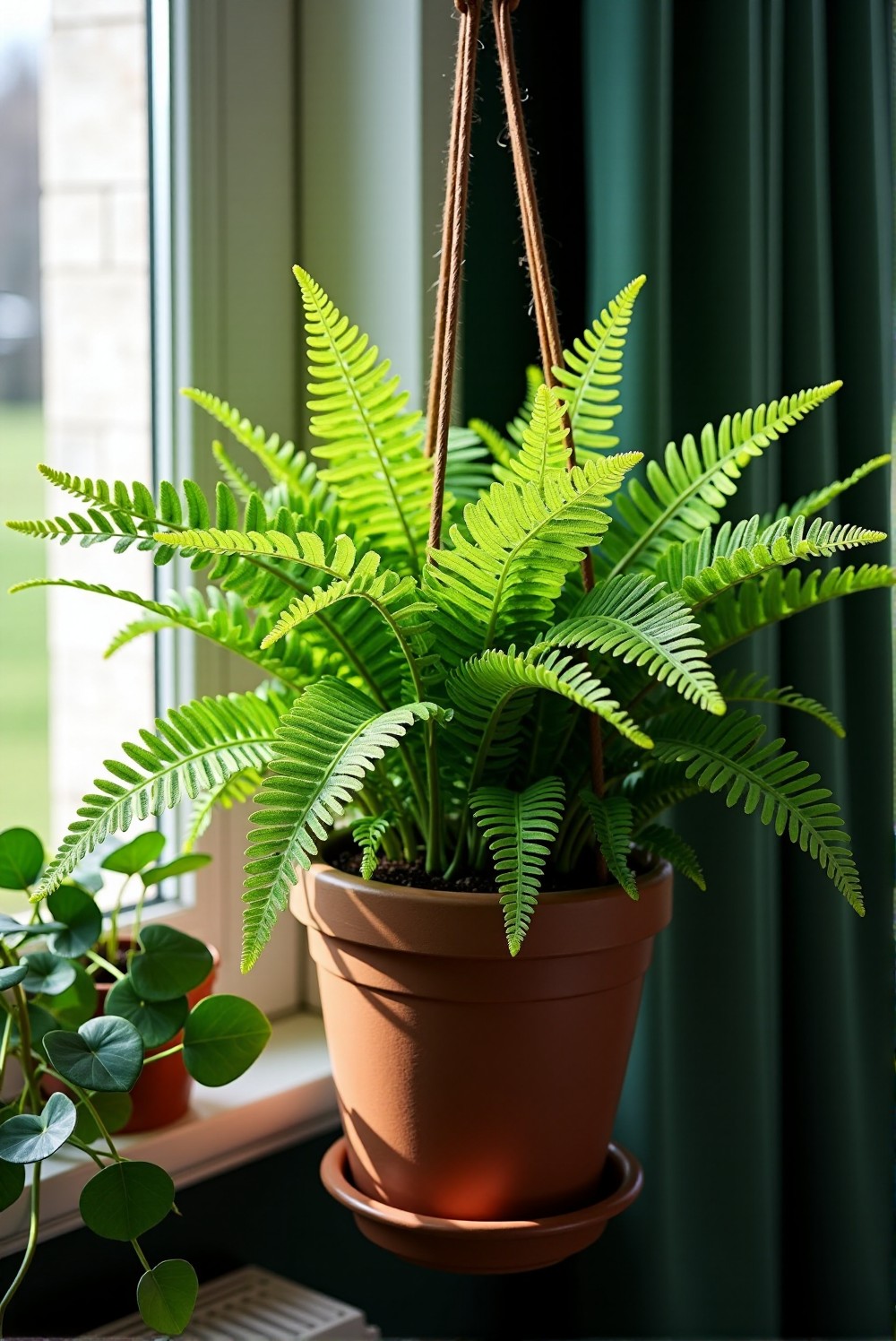
The Boston Fern, or Nephrolepis exaltata, is a delightful plant that brings life to any room. Its lush, feathery fronds create a full, green look that can brighten indoor spaces.
This fern is particularly fond of humidity, which makes it an ideal choice for bathrooms or kitchens where moisture levels are higher.
Maintaining a Boston Fern is relatively easy with a few key tips.
It thrives in bright, indirect sunlight, but it can also adapt to lower light environments. Consistent moisture is critical for this plant, so it’s best to keep the soil evenly damp.
Using a saucer filled with water and pebbles can help maintain humidity around the roots.
Regular misting helps the fern stay fresh and lush, as it loves high humidity.
This plant will thrive even more if you place it near a humidifier or in a well-lit bathroom. Occasionally, you may need to trim away any brown or dying fronds.
This not only keeps the plant looking its best, but it also promotes healthier growth.
Boston Ferns are also known for their air-purifying abilities.
They can help remove toxins from the air, contributing to a healthier indoor atmosphere. With their charming appearance and benefits, Boston Ferns are a wonderful option for those who enjoy houseplants in humid conditions.
Boston Ferns are not only aesthetically pleasing but also beneficial for improving indoor air quality. Here are some key advantages of incorporating them into your home:
- Excellent air purifiers, absorbing harmful pollutants and improving ventilation.
- Thrives in humid environments, making them ideal for bathrooms or kitchens.
- Low maintenance, requiring only periodic watering and indirect sunlight.
- Natural humidifiers that help maintain optimal moisture levels in the air.
- Available in various sizes, suitable for any room or space in your home.
4. Peace Lily
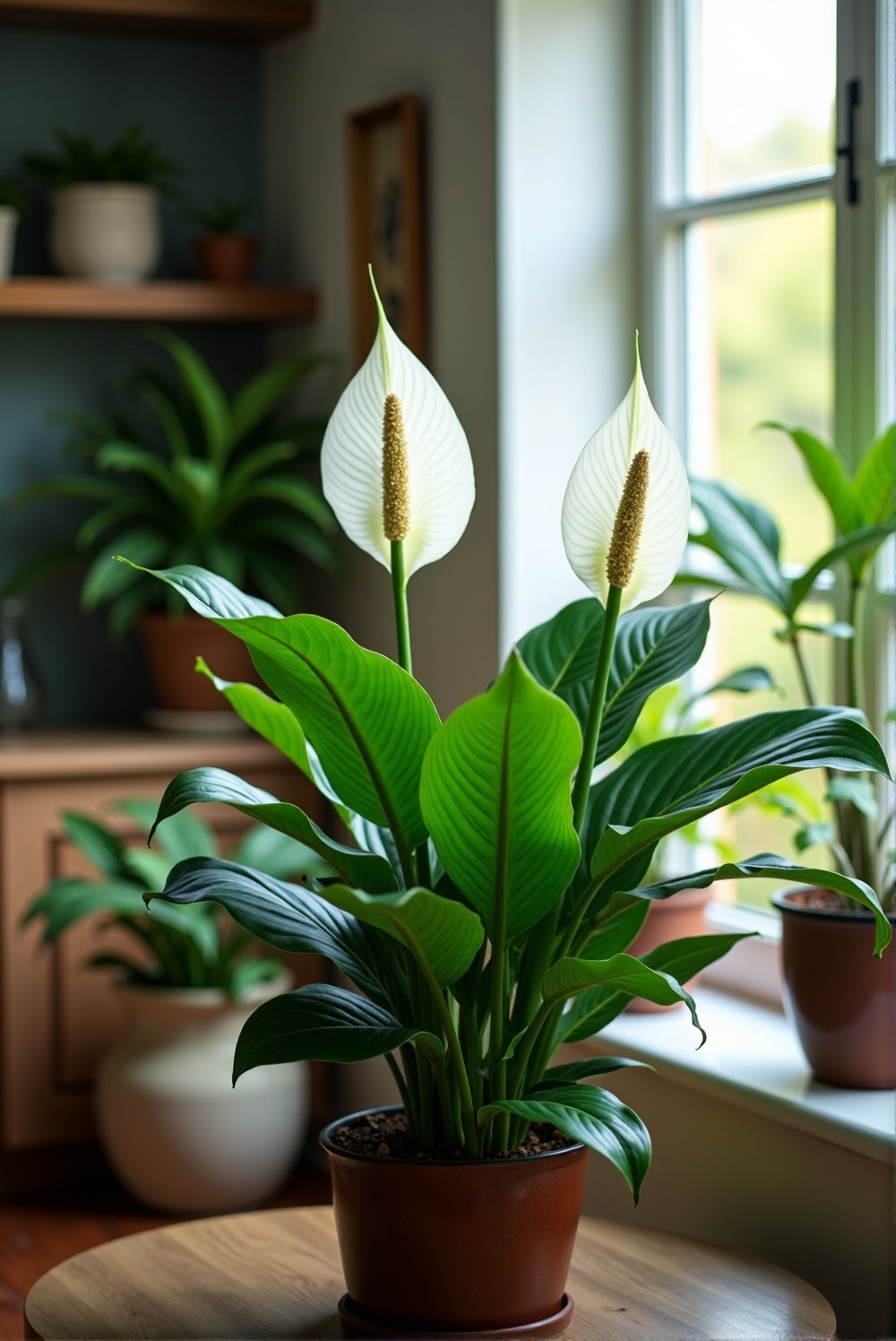
The Peace Lily, or Spathiphyllum, is a beautiful houseplant that thrives in low light and high humidity. Its shiny green leaves create a lush appearance, while its striking white flowers add a touch of elegance.
The Peace Lily, or Spathiphyllum, is an ideal choice for indoor gardening enthusiasts. This resilient plant is not only visually appealing, but also easy to care for. Here are some key features and benefits:
- Prefers low light conditions, making it suitable for various indoor spaces.
- Thrives in high humidity, perfect for bathrooms or kitchens.
- Helps purify the air by removing toxins, promoting a healthier environment.
- Requires minimal maintenance, ideal for busy individuals.
- Blooms multiple times a year, providing ongoing beauty and elegance.
This plant is often found in homes and offices, thanks to its easy care requirements.
The Peace Lily loves a humid environment, making it ideal for places like bathrooms or kitchens.
Keep the soil consistently moist but ensure it doesn’t get too soggy to avoid root rot. Regular misting of the leaves can enhance its growth and keep it fresh.
With its ability to tolerate low light, this plant is perfect for spaces where other plants might struggle. However, it prefers indirect sunlight for optimal growth.
If it receives too little light, it might stop blooming.
One of the standout features of the Peace Lily is its air-purifying capabilities.
It can filter out harmful toxins from the air, making your indoor space healthier to breathe. This is just one of the several benefits of having a Peace Lily in your home.
Furthermore, the Peace Lily is known for its resilience. If you forget to water it occasionally, it can bounce back quickly, showing you when it’s thirsty by drooping its leaves.
Once you water it, it perks up in no time.
This plant also blooms throughout the year with appropriate care.
When its white flowers appear, they signal that the plant is thriving. Proper fertilization during the growing season can help enhance flowering and overall health.
5. Snake Plant
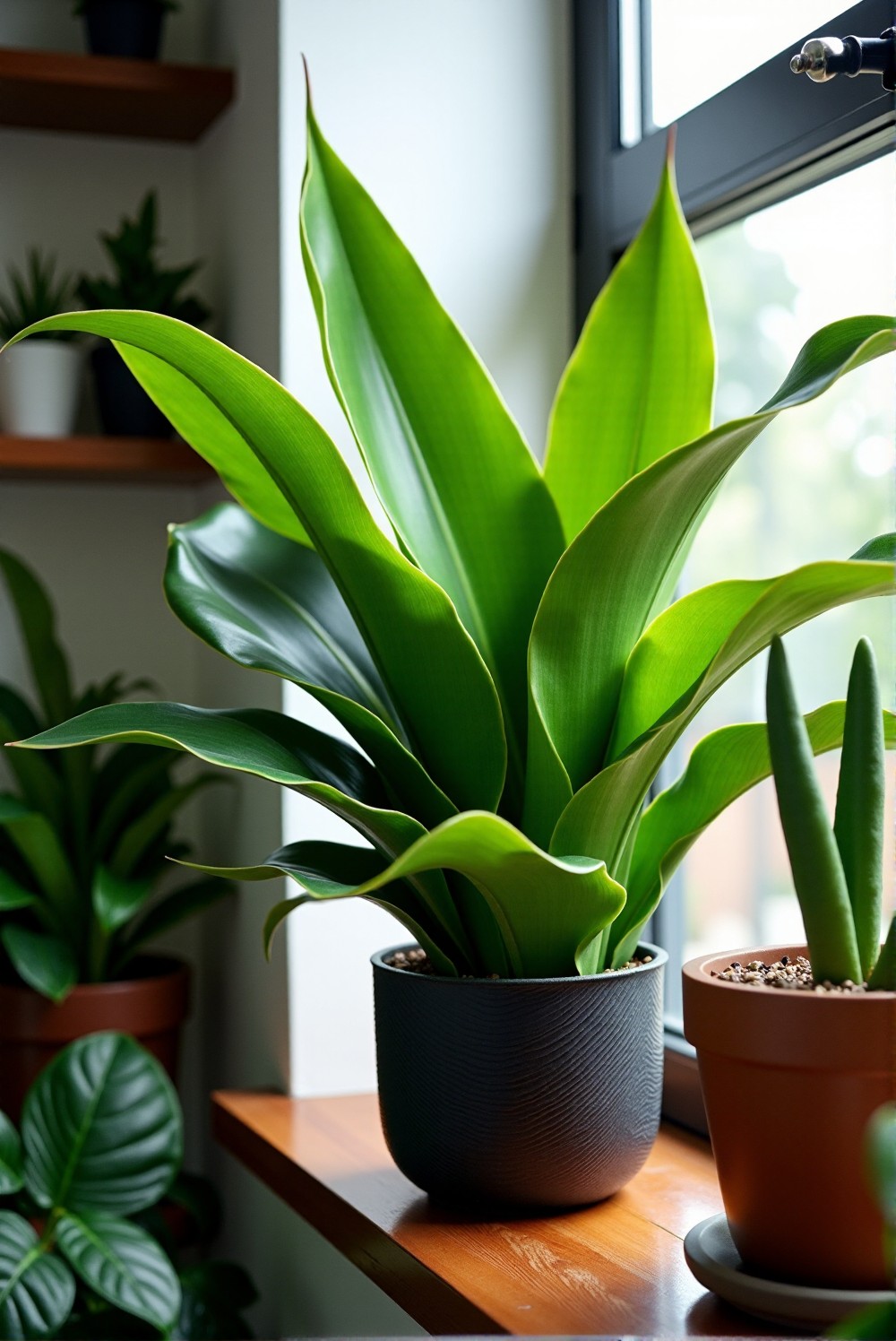
The Snake Plant, also known as Sansevieria or Mother-in-Law’s Tongue, is an excellent houseplant for humid conditions. Its long, upright leaves come in various shades of green, often banded with yellow or white edges, making it a striking addition to any room.
This plant thrives on neglect, which is perfect for busy people. It can survive in low light and doesn’t need a lot of water.
In fact, it’s best to let the soil dry out completely between watering.
Snake Plants are great for improving air quality.
They filter out toxins and release oxygen, making your home feel fresher. They can also help increase humidity levels, which is beneficial in dry environments.
For best results, place your Snake Plant in a spot with indirect sunlight. Too much direct sun can scorch the leaves.
If you notice browning tips, that might be a sign of too much light or water.
Another fascinating aspect of the Snake Plant is its ability to grow in various types of soil, as long as it drains well.
You can even propagate it by dividing the roots or taking leaf cuttings. This means you can easily create new plants from one you already have.
6. Bamboo Palm
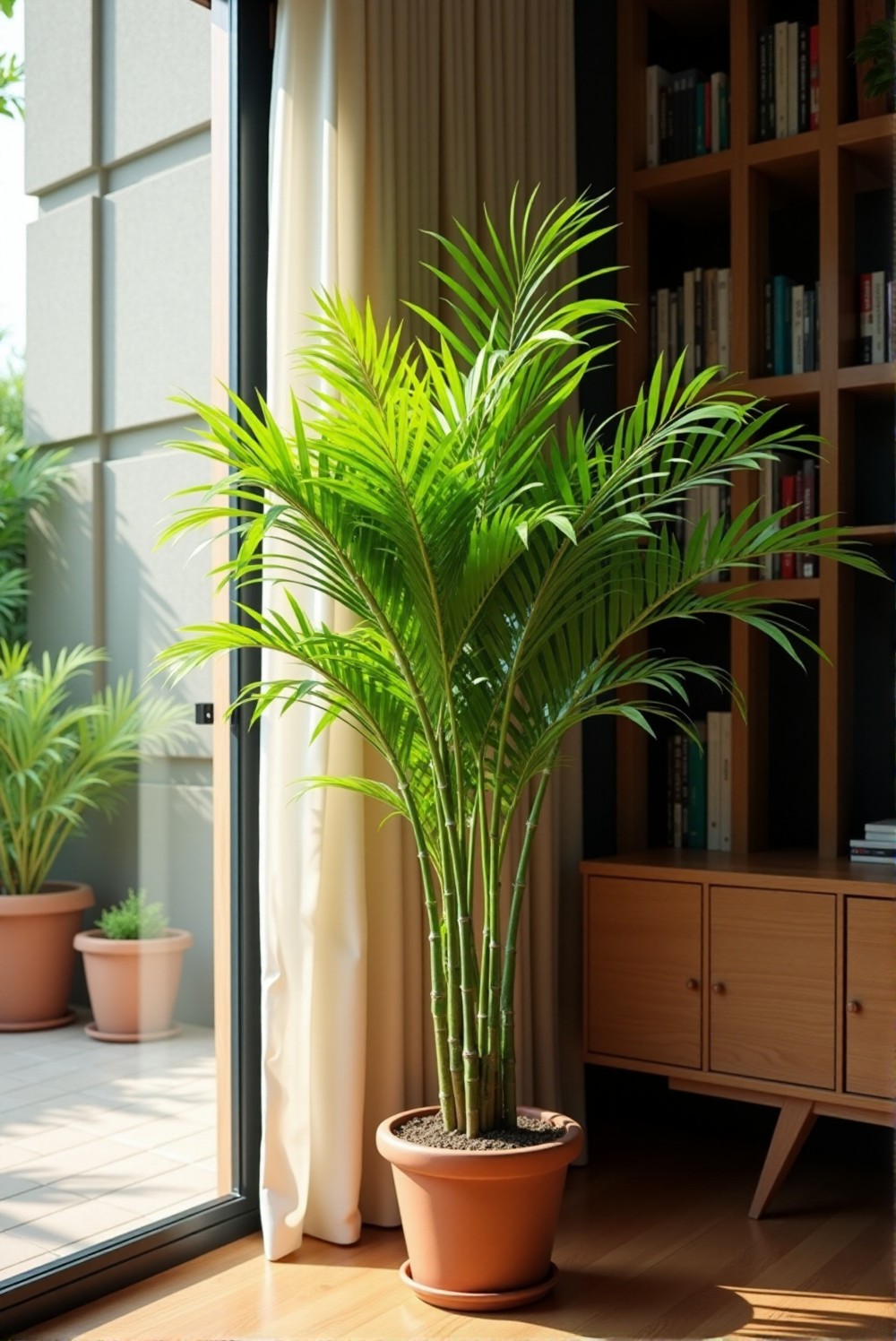
The Bamboo Palm, also known as Chamaedorea seifrizii, is a wonderful addition to homes that have high humidity. Its slender, bamboo-like stems and elegant leaves create a tropical vibe, making it perfect for indoor spaces.
This palm can grow to be quite tall, adding a lush look to your decor.
It thrives in bright, indirect light but can handle some shade, making it versatile for different rooms.
The Bamboo Palm enjoys moist soil but must not sit in water, as this can cause the roots to rot. Water it when the top inch of soil feels dry, and you’ll help it stay healthy.
Regular misting of the leaves is beneficial, especially in dry conditions. This can boost the humidity levels around the plant, which it loves.
To keep it looking its best, wipe down the leaves occasionally to remove dust.
This plant is not just appealing but also helps to purify the air.
It filters out harmful toxins, contributing to a cleaner indoor atmosphere. With proper care, the Bamboo Palm can be a stunning feature in your home that thrives on humidity while enhancing your indoor environment.
7. Philodendron
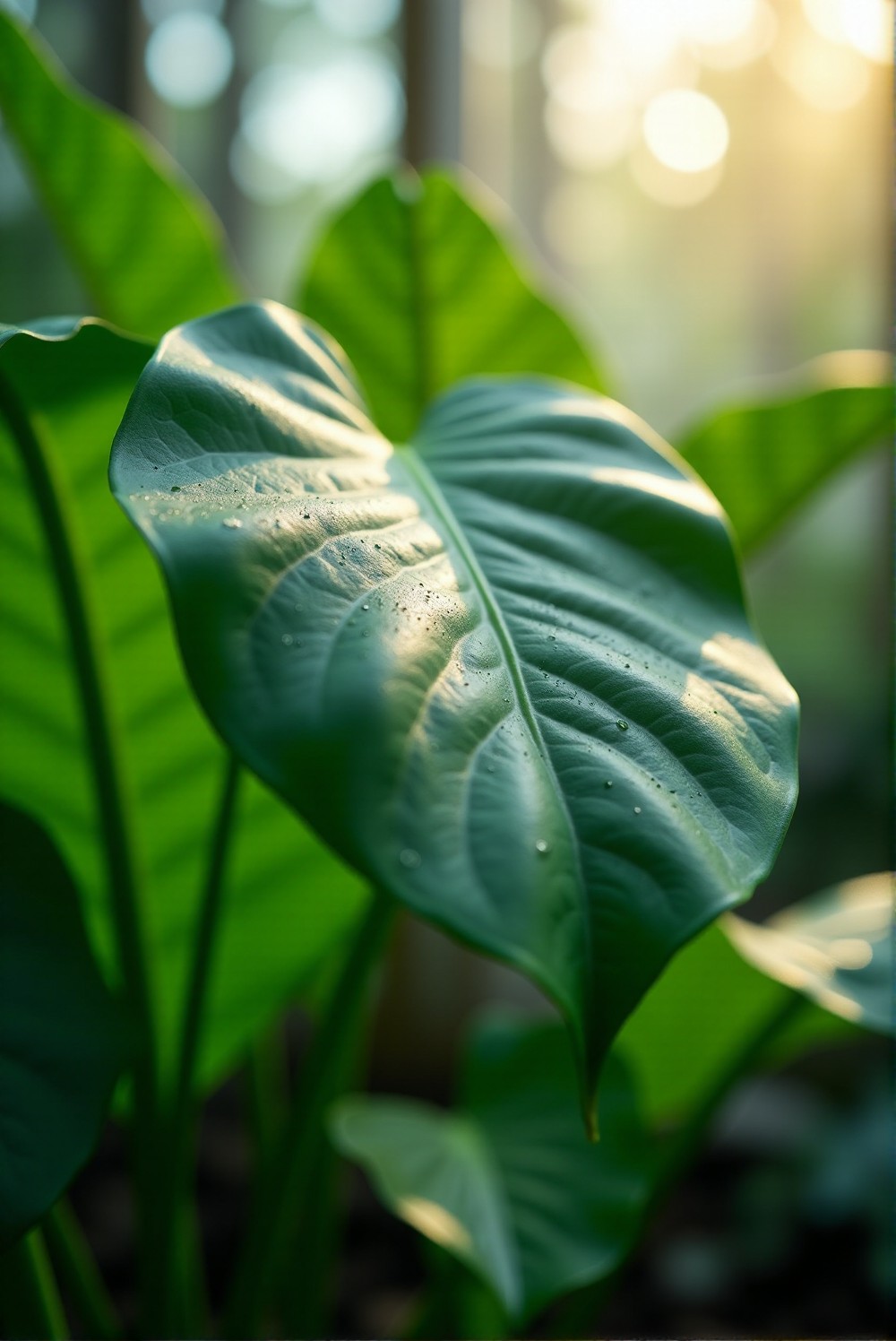
The Philodendron is a versatile houseplant that thrives in humid conditions. This popular plant features lush, green leaves that come in many shapes and sizes, making it a stunning addition to any room.
Philodendrons are easy to care for, perfect for both beginners and experienced plant lovers.
They prefer bright, indirect light but can adapt to lower light conditions.
While they enjoy humidity, ensure the soil is well-draining and not too soggy. Water your Philodendron when the top inch of soil feels dry.
Mist the leaves occasionally to boost humidity and keep them vibrant.
This plant is also known for its air-purifying qualities.
It can help filter out toxins from the air, making your home a healthier space. With their attractive foliage and easy-going nature, Philodendrons are ideal for enhancing indoor environments and bringing a touch of nature inside.
Another wonderful feature of Philodendrons is their ability to grow quickly. With the right care, they can produce new leaves frequently, adding to their beauty over time.
If you want to propagate, simply take a cutting and place it in water until roots develop.
Philodendrons are tolerant of occasional neglect, making them perfect for busy lifestyles.
Philodendrons are low-maintenance plants that thrive under various conditions. They are perfect for anyone looking to enjoy greenery without the pressure of demanding care routines.
- Place cuttings in water for about 2-4 weeks for optimal rooting.
- Keep the water clean and change it every few days to promote healthy root development.
- Choose a location with indirect light to encourage growth and prevent leaf burn.
- Philodendrons can tolerate low humidity, making them suitable for most home environments.
- Consider fertilizing during the growing season to enhance growth and vitality.
This resilience combined with their aesthetic appeal makes them a favorite choice for adding greenery to your home.
8. Calathea
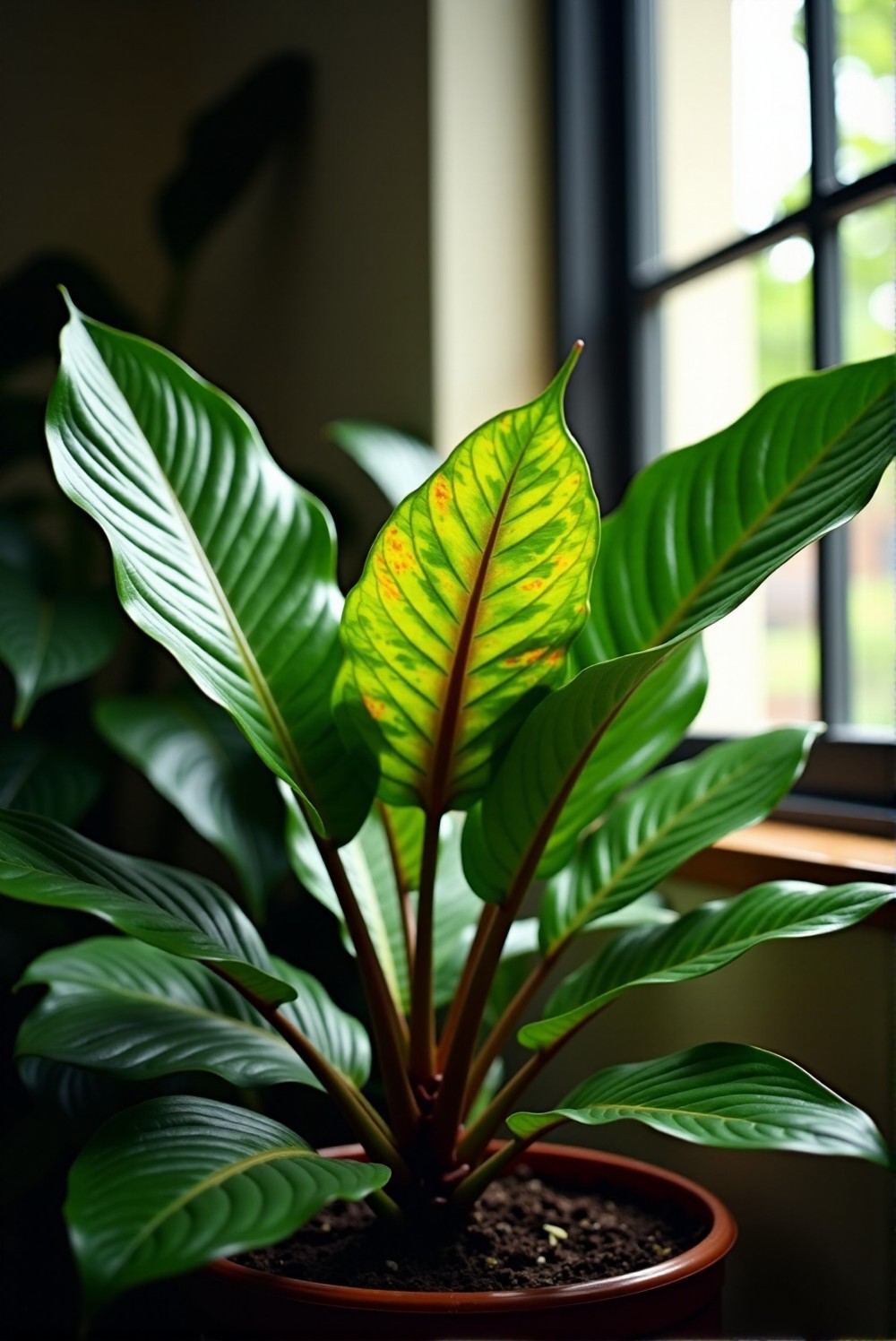
The Calathea is a stunning houseplant known for its beautiful, patterned leaves. It thrives in humid environments, making it great for bathrooms or kitchens where moisture is abundant.
Calatheas come in various types, each showcasing unique leaf designs and colors that can brighten any space.
Light is essential for this plant.
It prefers bright, indirect sunlight but can adapt to lower light conditions. Too much direct sun can harm the leaves, causing them to fade or burn.
Regular watering is key; the soil should remain moist but not soggy. It’s best to use distilled or rainwater, as Calatheas can be sensitive to chemicals found in tap water.
To ensure your Calathea thrives, follow these important care tips regarding watering:
- Water your Calathea when the top inch of soil feels dry to the touch.
- Avoid using hard water, as it can lead to brown leaf tips.
- Consider using a humidity tray or misting to maintain moisture around the plant.
- Monitor leaf color and texture; drooping or crispy leaves may indicate watering issues.
- During the growing season, increase watering frequency but reduce it in winter when the plant is dormant.
Misting the leaves regularly can help keep the plant healthy and promote humidity, which this plant loves. Additionally, Calatheas are known for their fascinating leaf movements.
They tend to raise and lower their leaves in a daily rhythm. This adds a lively touch to your indoor garden.
Calatheas also do well when given the occasional fertilizer during the growing season. This can help encourage new growth and keep the colors vibrant.
If you notice brown edges on the leaves, it might be a sign that the air is too dry or that the plant needs more water.
With proper care, Calatheas can thrive and grow beautifully, adding a splash of nature to your home.
They are perfect for both new and experienced plant lovers looking to enhance their indoor spaces with lush, eye-catching greenery.
9. Dracaena
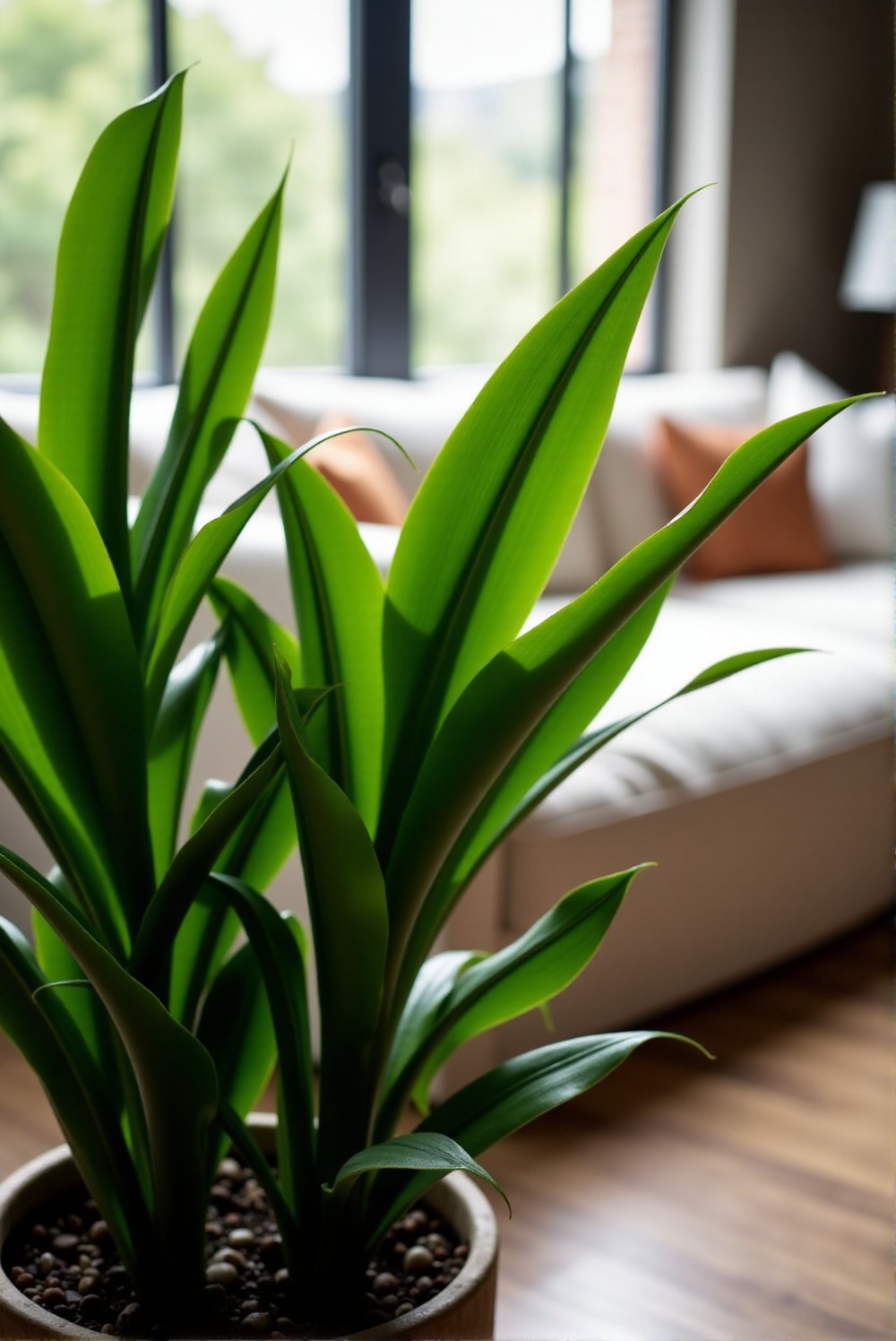
The Dracaena family consists of several popular houseplants, known for their striking appearance and ease of care. These plants feature long, slender leaves that can vary in color, from green to lighter shades with streaks or edges of yellow and white.
Whether you’re a plant novice or an experienced gardener, Dracaena can fit well into your home.
Humid environments suit Dracaena very well, making bathrooms and kitchens ideal spots.
While they prefer bright, indirect sunlight, some varieties can tolerate lower light conditions. It’s important to avoid direct sunlight, as it can scorch the leaves.
Watering should be done carefully; letting the top inch of soil dry out between sessions is best. Overwatering can harm the roots, so maintain a balance to keep the plant healthy.
Dracaenas are known for their resilience, as they can adapt to different conditions, making them a forgiving choice for those new to plant care.
These plants can help improve indoor air quality by filtering out toxins.
This feature adds to their popularity in homes and offices. Regular misting can provide the extra humidity they enjoy, particularly in dryer homes.
Propagation is straightforward; you can take cuttings and place them in water until roots develop. This means you can easily expand your collection of Dracaena plants.
With their elegant look and simple care requirements, Dracaena plants are a wonderful addition to any humid environment, offering both beauty and functionality.
10. ZZ Plant
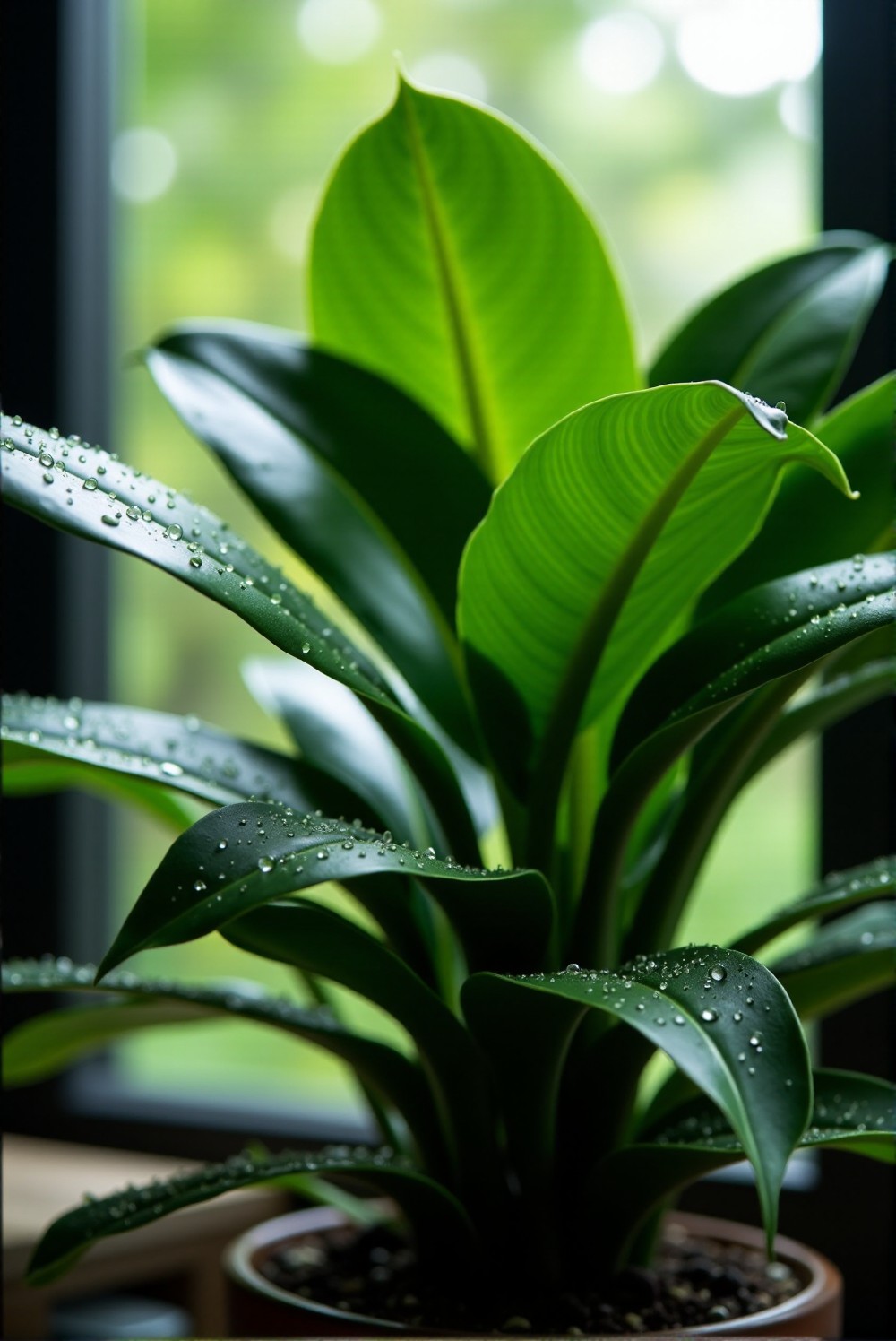
The ZZ Plant, known scientifically as Zamioculcas zamiifolia, is a fantastic choice for those who enjoy houseplants but may not have the time for complicated care routines. Its glossy green leaves are not only attractive but also resilient.
This plant is famous for its ability to thrive in low light, which is a big plus for indoor settings.
Despite its preference for bright, indirect sunlight, the ZZ Plant can adapt to shadier spots.
It doesn’t need frequent watering; in fact, it prefers a more forgiving approach. Allow the soil to dry out completely between waterings to prevent issues like root rot.
As for humidity, the ZZ Plant can manage well in both humid and dry environments. This flexibility makes it a great option for various rooms in your home, including those with higher moisture levels, like bathrooms or kitchens.
Just make sure to avoid overwatering.
This plant is also notable for its air-purifying qualities.
It filters out toxins in the air, improving indoor air quality. With proper care, it can grow tall, adding visual interest and greenery to any space.
Another appealing aspect of the ZZ Plant is its slow growth, which means it won’t take up too much space or require frequent repotting. Plus, it’s relatively pest-resistant, making it a low-maintenance choice for busy lifestyles.
Frequently Asked Questions
Here are some frequently asked questions about houseplants that thrive in humid conditions. This information can help you better understand how to care for them in your home.
What types of houseplants thrive in humid environments?
Many houseplants enjoy humid conditions, such as Pothos, Spider Plant, Boston Fern, and Peace Lily. These plants have adapted to grow well in high moisture levels, making them ideal for spaces like bathrooms and kitchens. Other favorites include Bamboo Palm, Philodendron, Calathea, Dracaena, and ZZ Plant. All of these plants are known for their ability to thrive in humidity while providing aesthetic appeal and air purification benefits.
How should I water these humidity-loving plants?
It’s important to let the top inch of soil dry out before watering most of these plants. Overwatering can lead to root rot, which is particularly hazardous for species like Pothos and Snake Plant. During hotter months or in very humid environments, these plants might require a little more water but keep an eye on the soil’s moisture levels. Regular misting can also help maintain humidity around the plant, especially for those like Calathea and Boston Fern that thrive on it.
What light conditions are best for these houseplants?
Most of the plants mentioned prefer bright, indirect light, but many can adapt to lower light conditions. For example, the Pothos and ZZ Plant can do well in shadier spots. However, direct sunlight can be harmful to many of these plants and can cause leaf burn or fading colors. It’s best to place them where they can receive filtered light for optimal growth while avoiding harsh sun exposure.
Can these plants help improve indoor air quality?
Yes, many of these plants are renowned for their air-purifying qualities. For instance, Peace Lily and Boston Fern can filter out harmful toxins and contribute to a healthier indoor atmosphere. They work by absorbing pollutants and releasing oxygen, enhancing the air quality we breathe at home. Incorporating these plants into your living space not only adds beauty but also provides the added benefit of cleaner air.
Are these plants safe for pets?
Some of the plants listed, like Spider Plant and Boston Fern, are generally considered safe for pets. However, plants such as Pothos and Peace Lily can be toxic to animals if ingested. It is critical to research specific plants and their effects on pets before bringing them into your home. For pet owners, focusing on non-toxic plant options helps ensure a safe environment for furry companions.
How often should I fertilize these houseplants?
Fertilizing schedules can vary, but generally, these plants benefit from light feeding every few months during the growing season. It’s best to use a balanced, water-soluble fertilizer diluted to half strength. Over-fertilization can harm your plants, so it’s important to err on the side of caution. Observing your plants’ growth and adjusting your fertilizing routine accordingly can promote healthy, vibrant foliage.
How can I propagate these plants?
Many of the humidity-loving plants can be easily propagated, allowing you to create new plants from existing ones. For example, Pothos and Philodendron can be propagated by taking cuttings and placing them in water until roots develop. Spider Plants produce baby plants, or spiderettes, which can be potted separately. By understanding the propagation methods for each plant, you can expand your collection or share with friends.
Conclusion
Choosing houseplants that thrive in humid conditions can bring beauty and life to your indoor spaces. Plants like Pothos, Spider Plant, and Boston Fern not only enhance your home decor but also improve air quality with their air-purifying abilities.
With a little care and attention, these plants can flourish in environments like bathrooms and kitchens where humidity is higher. Many of them are easy to maintain, making them perfect for both beginners and seasoned plant lovers.
So, whether you’re creating a cozy corner filled with greenery or simply looking to improve your indoor air, consider adding some of these humidity-loving houseplants to your collection. Your home will not only look great, but you’ll also enjoy the benefits of fresher air and a more vibrant space.